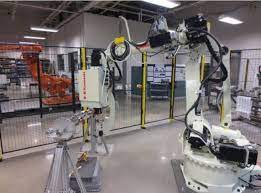Advancements in Collaborative Robot Welding: A Game-Changer for the Manufacturing Industry

In the ever-evolving landscape of manufacturing, robotic automation has become an indispensable tool for improving efficiency, precision, and productivity. Among the various applications of robots in manufacturing, welding is a critical process that demands a high degree of precision. Collaborative robot welding, or cobot welding, has emerged as a transformative technology in recent years. This article explores the concept of collaborative robot welding, its benefits, applications, and the potential it holds for the future of manufacturing.
What is Collaborative Robot Welding?
Collaborative robot welding is a cutting-edge welding technology that combines the capabilities of industrial robots with advanced sensing and control systems to create a safer and more efficient welding environment. Unlike traditional welding robots, which are often confined to cages to ensure human safety, collaborative welding robots can work alongside human operators without the need for extensive safety measures.
Key Features and Benefits
- Safety: One of the primary advantages of collaborative robot welding is its inherent safety. These robots are equipped with sophisticated sensors and software that allow them to detect the presence of humans and adjust their speed or shutdown if they come too close. This feature not only reduces the risk of accidents but also eliminates the need for expensive safety barriers.
- Ease of Programming: Collaborative robots are designed to be user-friendly, with intuitive programming interfaces that do not require extensive technical expertise. This makes it easier for manufacturers to deploy and reprogram these robots for various welding tasks, reducing setup time and costs.
- Space Efficiency: Cobots are typically compact and can be easily integrated into existing production lines, saving valuable floor space. Their flexibility allows them to work in confined spaces, making them ideal for small and medium-sized manufacturers.
- Improved Quality: Collaborative robots are highly precise and consistent in their welding operations. This leads to higher quality welds and reduces the need for costly rework, ultimately improving product quality and reducing production costs.
Applications of Collaborative Robot Welding
- Automotive Industry: The automotive industry was one of the early adopters of collaborative robot welding. Cobots are used for various welding tasks, such as body-in-white welding, chassis welding, and spot welding. Their ability to work alongside human operators has revolutionised automotive assembly lines.
- Aerospace: In the aerospace industry, where the highest standards of quality and precision are essential, collaborative robot welding is being used for tasks like welding aircraft components and assembling rocket parts. The technology’s ability to work with exotic materials like titanium and aluminium is a significant advantage.
- Construction and Infrastructure: Collaborative robot welding is also making inroads in the construction and infrastructure sectors. Cobots are employed for on-site welding tasks, such as bridge construction, pipeline welding, and structural welding in high-rise buildings.
- Shipbuilding: Shipbuilding is another industry benefiting from collaborative robot welding. These robots are used for welding large and complex ship components, improving welding quality and reducing the need for manual labor in hazardous environments.
The Future of Collaborative Robot Welding
The future of collaborative robot welding looks promising, with ongoing advancements and innovations in the field. Some key trends and developments to watch for include:
- AI and Machine Learning: Integration of artificial intelligence and machine learning algorithms will enable cobots to adapt and learn from their experiences, enhancing their welding capabilities and efficiency.
- Increased Payload and Reach: Future cobots will likely have larger payloads and extended reach, allowing them to handle even more complex welding tasks and work in larger workspaces.
- Enhanced Sensing and Vision Systems: Improved sensors and vision systems will enable cobots to have a better understanding of their environment, leading to more precise and adaptive welding processes.
Collaborative robot welding is a transformative technology that is revolutionising the manufacturing industry. Its safety, ease of programming, space efficiency, and quality improvements make it an attractive choice for a wide range of applications. As technology continues to evolve, collaborative robot welding holds the promise of further enhancing efficiency, precision, and productivity in manufacturing, ultimately shaping the future of this vital industry. Manufacturers willing to embrace this technology are poised to gain a competitive edge in the ever-evolving world of production. For more information visit Cyber-Weld




